Nail Your Chess Notation to the Wall
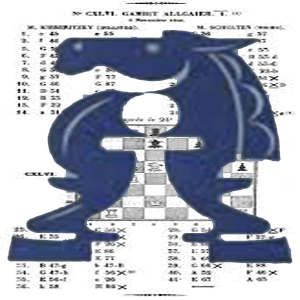
Chess notation is a simple idea that has allows us to record and study chess games. It's as important to know your way around the board as the glossaries to build your chess knowledge and general strategic know-how.
Some people can see a game played out in their mind's eye simply by reading the moves written down in chess notation.
Some people can see a game played out in their mind's eye simply by reading the moves written down in chess notation.
While it's not necessary to be able to do this to become a good player it is true that the better your visualization skills become, the more formidable a player you will be.
But that is a separate discussion. Right now you and I will take the opportunity to examine and comprehend notation, what it's for and how it works.
Algebraic Notation
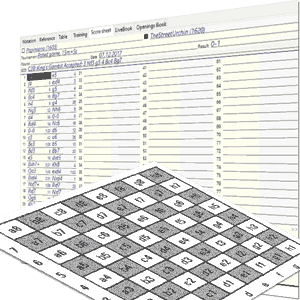
Algebraic notation is the most widely used form of notation. It has completely replaced descriptive notation as the standard notation today with universal usage. The files are labeled alphabetically a-h and the ranks are labeled numerically 1-8.
Each of the 64 squares has a unique name taken from the cross reference of it's file denoted by the letter and it's rank denoted by the number. So the squares are named with the 64 possible combinations from a1 right through to h8.
The pieces are named in English as follows: King=K, Queen=Q, Rook=R, Bishop=B, Knight=N. The pawns do not have any letters to indicate their moves. The destination square is quoted only.
The pieces are named in English as follows: King=K, Queen=Q, Rook=R, Bishop=B, Knight=N. The pawns do not have any letters to indicate their moves. The destination square is quoted only.
If a King moves to c6 on lets say move 31 for example the move is recorded as 31.Kc6, If he takes an enemy piece on this move it goes down as 31.Kxc6. If a pawn promotes to Queen on b1 on move 45 we write this as 45...b1Q (the 3 dots after 45 indicate that this was Black's move). Short castle is 0-0, long castle is 0-0-0.
Descriptive Notation
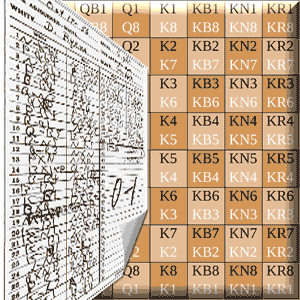
Descriptive notation is an older form of chess notation that was widely used to describe chess games before the advent of the algebraic system. Since being replaced it's usage has been largely curtailed.
Every square has 2 names under this system, one from White's point of view and one from Black's. The ranks are still numbered 1-8 with rank 2 from White's point of view considered as rank 7 from Black's.
The files instead of being labeled as letters a-h are described as follows: a=QR, b=QN, c=QB, d=Q, e=K, f=KB, g=KN, h=KR. Fortunately due to the symmetrical nature of the chess set-up, the files are the same for both sides.
The files instead of being labeled as letters a-h are described as follows: a=QR, b=QN, c=QB, d=Q, e=K, f=KB, g=KN, h=KR. Fortunately due to the symmetrical nature of the chess set-up, the files are the same for both sides.
A pawn move recorded under algebraic notation as 1.e4 would read as 1.P-K4. 12...Bg4 would read 12...B-KN5. If a Bishop captures a Knight for example it is recorded simply as BxN. Castling is the same as algebraic and a pawn promoting to Queen on b8 for example can be written as P-QB8(Q), P-QB8/Q or even P-QB8=Q.
Numeric Chess Notation
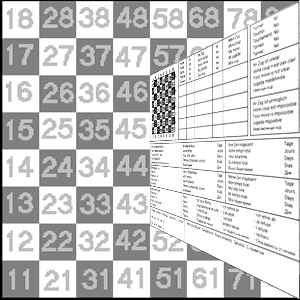
Numeric notation is the system used for correspondence chess. It is very similar to algebraic with respect to labeling the squares. The only difference is there are no letters used. Both files and ranks are labeled 1-8, each square has only one label same for both sides. So g7 in algebraic is 77 in numeric. d3 is 43 and so on.
Moves are written by entering the two digits for the square the piece is leaving followed by the two digits for the destination square. 1.e4 in algebraic is 1.5254 in numeric.
A fifth digit is added when a pawn is being promoted. The fifth digit is 1 for a Queen, 2 for a Rook, 3 for a Bishop or 4 for a Knight. So if on Black's 39th move for instance he is promoting a pawn to a Queen with d2 to d1 it is written in numeric notation as 39...42411.
A fifth digit is added when a pawn is being promoted. The fifth digit is 1 for a Queen, 2 for a Rook, 3 for a Bishop or 4 for a Knight. So if on Black's 39th move for instance he is promoting a pawn to a Queen with d2 to d1 it is written in numeric notation as 39...42411.
To record a castling move you just use the King's departure and destination squares, White's short castle would be 5171 and so on. Captures aren't mentioned specifically in a capturing move just the two squares in a four digit number like any other move.
Moving On
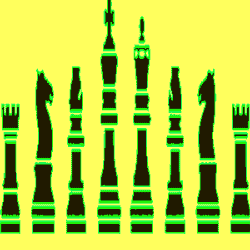
Chess notation is important to understand as you need to know the board like the back of your hand. Of all the different notations, we simply looked at the three main ones here, algebraic is the one you should concentrate on.
It is the most important one as it is now the worldwide standard for recording chess games. Descriptive notation is now obsolete and numeric notation is used for correspondence chess.
The minimum standard you should reach with algebraic notation is knowing each square from a1 to h8 as soon as you lay eyes on it without looking at the letters and numbers at the side of the board to cross-reference it.
The minimum standard you should reach with algebraic notation is knowing each square from a1 to h8 as soon as you lay eyes on it without looking at the letters and numbers at the side of the board to cross-reference it.
Hopefully one day you'll be able to see games played out in your mind's eye simply by reading the notation. When you get the hang of chess notation you will then be ready to start thinking about chess basics.

